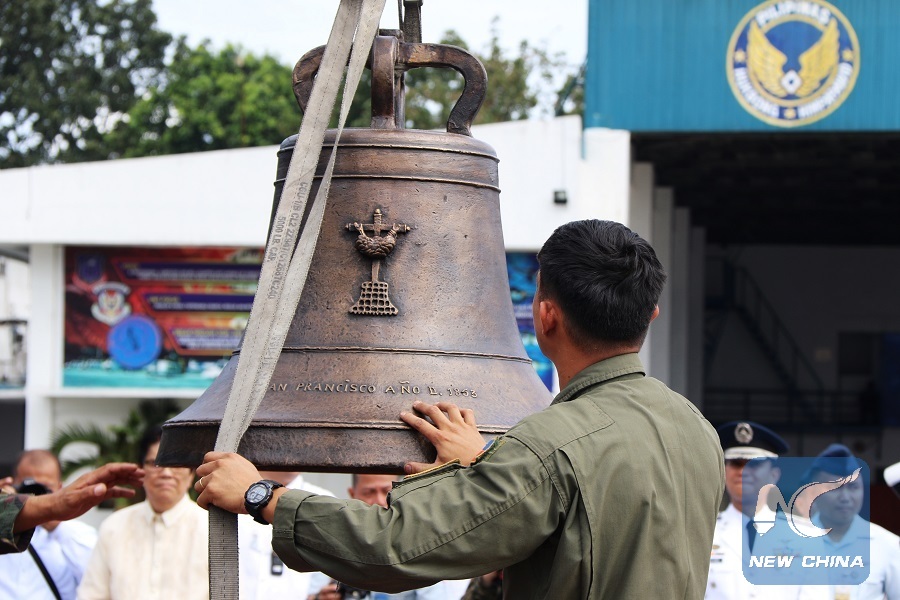
Photo taken on Dec. 11, 2018 shows a bell returning ceremony held at a Philippine air force base in Manila, the Philippines. (Xinhua/Zheng Xin)
MANILA, Dec. 11 (Xinhua) -- After 117 years, the United States finally returned three original church bells taken by the American soldiers as war booty during the Philippine-American war in 1901.
Filipinos welcomed the return of the Bells of Balangiga, named after a small seaside central Philippine town. Some Balangiga residents cried when they saw on television the three bells being handed over to Philippine officials by the Americans.
Indeed, the return of Balangiga bells reminds people of a dark chapter in the relations between the Philippines and the United States.
"Now they are home. They are going back to where they belong. It's time for healing, AND it's time for closure," the Philippine Defense Secretary Delfin Lorenzana said in his speech during the handover ceremonies at Villamor Air Base on Tuesday.
RETURN OF BALANGIGA BELLS
A U.S. Air Force plane bearing the three historic bells landed in the Philippines on Tuesday morning. U.S. officials led by U.S. Ambassador to the Philippines Sung Kim handed the bells to Lorenzana after their arrival at a Philippine Air Force Base (PAF) in Manila.
Other officials witnessed the ceremony, including Executive Secretary Salvador Medialdea.
A handful of people from Balangiga town in Eastern Samar were also present at the ceremony. They cheered as the bells were being unloaded from the plane and unboxed.
The bells were later taken to the PAF museum where they will be opened for public viewing for two days. They will be flown to Balangiga town in Eastern Samar on Saturday for turnover to the townspeople.
"It is a most memorable day of our nation's history and we celebrate it with deep gratitude and respect for all those who helped to make this day happen," Lorenzana said in his remarks during the handover ceremony, expressing hope that the return of the church bells will bring closure to that painful conflict that happened at the turn of the century.
"It is our hope that we will no longer remind us of that painful episode of our joint history. Instead, let them serve as a memorial to those soldiers who fought valiantly for their country," Lorenzana said.
Chief Presidential Legal Counsel and Presidential Spokesperson Salvador Panelo said on the same day, "today marks a watershed in our nation's history."
"As we move forward in our history, we hope that the bells of Balangiga will become constant reminders of our people's gallantry, heroism, and a strong sense of national pride," he said.
BALANGIGA MASSACRE
The three bells were seized by American soldiers from a Roman Catholic church in Balangiga, 117 years ago as war trophies after American soldiers killed the town's thousands of people, a tragedy historically known as the "Balangiga massacre".
Prior to the massacre, local Filipinos from Balangiga town pealed the church bells to signal an attack against American soldiers at the dawn of Sept. 28, 1901. Forty-eight out of 74 American soldiers belonging to the Ninth U.S. Infantry were killed by villagers armed with improvised weapons.
Since former Philippine president Fidel Ramos first raised the issue of the bells with then U.S. President Bill Clinton in 1993, a number of Philippine presidents and defense secretaries have demanded the return of Balangiga bells.
During his State of the Nation Address in July last year, Philippine President Rodrigo Duterte specifically demanded the return of the bells.
"Give us back those Balangiga bells. They are ours. They belong to the Philippines. They are part of our national heritage. Please return them. This is painful for us," Duterte said.
After one year, the U.S. embassy in Manila announced in August that the U.S. defense department had agreed to return the bells to the Philippines.
SYMBOLIC GESTURE
While the U.S. ambassador said on Tuesday that the return of the Balangiga bells "underscores the enduring friendship between our countries," some Philippine experts thought it could barely improve the current U.S.- Philippines relationship.
Renato De Castro, an international studies professor at the Philippine De La Salle University, told Xinhua that the return of the Balangiga bells is no more than a "symbolic" gesture and will not change Duterte's indifference towards the United States.
De Castro said the main reason that the United States is willing to return the Balangiga bells after 117 years is Duterte kept asking for them.
Asked if the return of the bells will change the current administration's attitude toward the United States, De Castro said he doubted it very much.
Duterte will only use the return of the Balangiga bells to show that his independent foreign policy is effective, he said.

